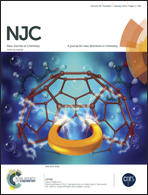Origin of the relaxation barriers in a family of MReIV(CN)2 single-chain magnets (M = MnII, NiII, and CoII): a theoretical investigation†
Abstract
Through investigation of the origin of the relaxation barriers and the magneto-structural correlations in three (DMF)4MReIVCl4(CN)2 (DMF = dimethylformamide; M = MnII (1), NiII (2), and CoII (3)) single-chain magnets (SCMs) in the intermediate regime between the Ising and the Heisenberg limits using hybrid functional theory (B3LYP) and complete active space second-order perturbation theory (CASPT2) methods, we succeeded in obtaining the magnetic anisotropy and correlation energy barriers ΔA and Δξ in terms of D (magnetic anisotropy parameter), J (magnetic exchange coupling constant), and S (spin value). B3LYP calculations show that the antiferromagnetic ReIV–MnII coupling interactions decrease with the increase of the Mn–N–C angle, while the ferromagnetic ReIV–NiII coupling interactions increase with the increase of the Ni–N–C angle. But, the ReIV–CoII exchange interactions with the variation of the Co–N–C angle are almost the same. The total energy barriers Δτ of 1 and 2 mainly come from the contribution of the transverse anisotropy of ReIV, while the MnII and NiII ions only transmit the exchange coupling between ReIV and almost have no contributions. For 3, however, both of the ReIV and CoII ions have contributions to the total energy barrier.


 Please wait while we load your content...
Please wait while we load your content...